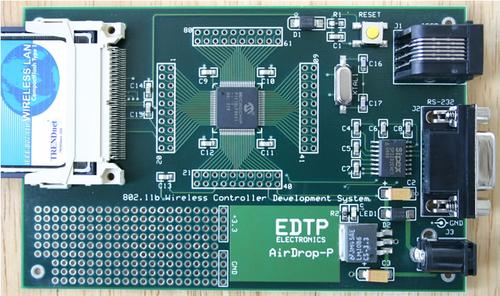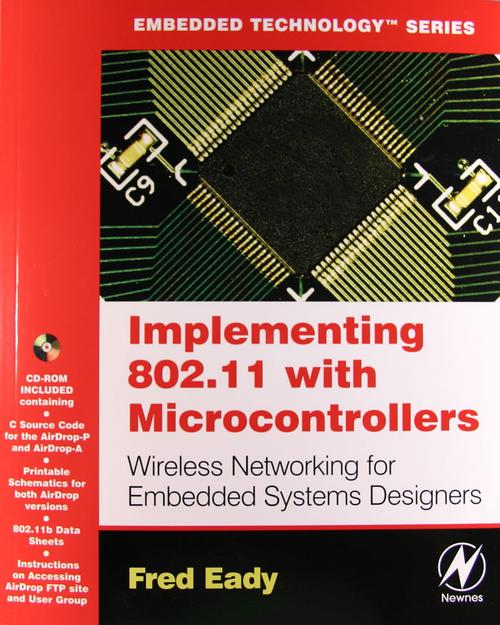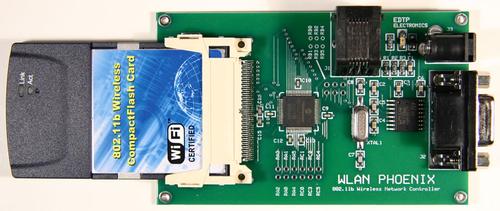October 8, 2015

Microchip offers WiFi in an XBee-compatible plug-in module known as WiFly. ACKme calls its XBee-socketable WiFi module Hopper. Each module contains an embedded TCP/IP stack and serial interface, so putting them on the air is relatively simple. Apply power and connect the module's serial port to a terminal emulator, provide a bit of vital network configuration information, and you're in business.
Implementing embedded WiFi hasn't always been that straightforward. Back in 2004 the closest thing to embedded WiFi consisted of a raw 802.11b radio housed in a Compact Flash package. The word "embedded" was not in the WiFi CF card sales manual, as the card was intended for use in personal digital assistants and Linux-driven devices. I forced the WiFi CF card to become embedded by attaching its I/O pins to a microcontroller.To reach my goal of embedded WiFi via microcontroller, I depended on publicly available Linux drivers and a tenuous relationship with the 802.11b radio developers at Intersil. At the time, their PRISM radio system that resided within the CF card was treated as top secret.
After a month or so of wrangling with sketchy documentation, I produced my first microcontroller-based WiFi board (see photo). I called it AirDrop. The first AirDrop was powered by a Microchip PIC microcontroller. An Atmel version dubbed AirDropA (photo) followed closely behind the renamed PIC-hosted AirDropP. The TCP/IP stack that stood behind the AirDrops was a modified version of my home-brewed TCP/IP stack, which I wrote for the wired embedded Ethernet designs found in my first book, Networking and Internetworking with Microcontrollers.



In 2005, I conveyed my AirDropA and AirDropP experiences in my second book, Implementing 802.11 with Microcontrollers (cover shown in Figure 1). The AirDropP took a trip to a Microchip MASTERS Conference lecture room in July 2006.
The age of the AirDrops came to a close in 2008. The PRISM-powered 802.11b CF WiFi cards became obsolete and began to disappear on the open market. One last rise from the ashes for the CF WiFi card came in 2009 with my WLAN Phoenix design (photo).It didn't take long for things to pick back up. In January 2010, Microchip acquired ZeroG Wireless, and in the following month, I designed and built the ZeroG PIC24FJ128GA006 Trainer (photo). For the first time, I was able to design and assemble a truly embedded 802.11b system. This was also the first time I took a wireless communications protocol lecture to MASTERS. A pair of ZeroG Trainers made the trip.


Over time, the ZeroG radios became the Microchip MRF series of WiFi modules. With the new name came new embedded WiFi designs with more powerful 32-bit microcontrollers (Photo 5). The MRF series of WiFi modules added 802.11g capabilities to my embedded designs.
MORE ARTICLES BY FRED EADY:
I'm still building embedded WiFi devices. My latest embedded WiFi design will appear in an upcoming Design News lecture series. The new design features a WiFi module that is loaded with a full-blown TCP/IP stack and programmable I/O subsystem -- all driven by a fully programmable internal 32-bit ARM processor. Now, are you sitting down? This tricky little ARM-driven WiFi module costs less than that 2004 Compact Flash WiFi card.

Fred Eady is the owner of EDTP Electronics, which was established in 1988 following the publication of his first magazine article. Since the formation of EDTP Electronics, Fred has written thousands of magazine articles. He has written for all of the major electronic magazines, including Radio Electronics, Electronics Now, Nuts and Volts, Servo, MicroComputer Journal, and Circuit Cellar. To date, he has authored four books and contributed to a fifth. He currently works as a PIC microcontroller consultant and is a Microchip Authorized Design Partner. Fred also authors monthly columns in Nuts and Volts and Servo magazines. His customers include machine shops, specialty startup companies, medical machine manufacturers, coin-operated device businesses, and various other research and development companies. He has a very close working relationship with Microchip Technology, the manufacturer of PIC microcontrollers, and has taught Ethernet and WiFi classes at Microchip's annual Masters Conference.
About the Author(s)
You May Also Like





